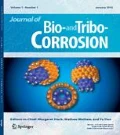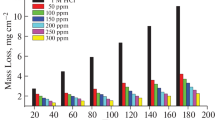Abstract
The inhibitive action of Cerumium rubrum extract against the corrosion of Al in a 1-M HCl environment was examined using conventional electrochemical and chemical methods. The results indicate that the extract exhibited excellent anticorrosive properties of aluminum in HCl reaching approximately 86.2% at 300 ppm at 318 K. It obeys the Langmuir adsorption isotherm. Polarization curves indicate that the extract acts as a mixed-type inhibitor. Moreover, the kinetic and thermodynamic parameters for the corrosion reaction were estimated and debated. The covering film established by the extract was checked by several techniques. All techniques gave similar results.















Similar content being viewed by others
References
Kasuga B, Park E, Machunda RL (2018) Inhibition of Al corrosion using carica papaya leaves extract in sulphuric acid. JMMCE 6:1–14
Raghavendra N, Bhat JI (2018) Protection of Al metal in 0.5 M HCl environment by mature arecanut seed extracts: a comparative study by chemical, electrochemical and surface probe screening techniques. J Phys Sci 29(1):77–99
Narasimha R, Jathi IB (2018) Red arecanut seed extract as a sustainable corrosion inhibitor for Al submerged in acidic corrodent: an experimental approach towards zero environmental impact. Period Polytech Chem Eng 62(3):351–358
Raghavendra N, Hublikar LV, Patil SM, Ganiger PJ, Bhinge AS (2019) Efficiency of sapota leaf extract against Al corrosion in a 3 M sodium hydroxide hostile fluid atmosphere: a green and sustainable approach. Bull Mater Sci 42(226):1–11
Fouda AS, Etaiw SH, Hammouda M (2017) Corrosion Inhibition of Al in 1 M H2SO4 by Tacoma non-aqueous extract. J Bio Tribo-Corros 3(3):3–29
Abakedi OU (2017) Al corrosion inhibition by Microdesmis puberula leaf extract in 2 M HCl solution. Int J Inno Sci Eng Tech Res 5(3):6–14
Mary AC, Suruthi KS (2018) Chrysanthemum flower extract as a green inhibitor for Al corrosion in alkaline medium. Int J Chemtech Res 11(7):37–44
Abdel-Gawad SA, Osman WM, Fekry AM (2019) Characterization and corrosion behavior of anodized Al alloys for military industries applications in artificial seawater. Surf Interfaces 14:314–323
Abdel-Gawad SA, Osman WM, Fekry AM (2019) A development of novel Ni-P coating on anodized Al alloys for military industries applications in artificial sea water. Surf Eng 35(12):1033–1041
Ghoneim AA, Ameer MA, Fekry AM (2012) electrochemical behavior of Al-Si alloy in phosphoric acid containing halogen or oxyhalogen anions. Int J Electrochem Sci 7(7):10851–10864
Raghavendra N, Bhat JI (2018) Anti-corrosion properties of areca palm leaf extract on Al in 0.5 M HCl environment. S Afr J Chem 71:30–38
Ennouri A, Lamiri A, Essahli M (2017) Corrosion inhibition of aluminum in acidic media by different extracts of Trigonellafoenum graecum L. seeds. Port Electrochim Acta 35(5):279–295
Olawale O, Ogundipe BJO, Julius S, Abayomi ST (2018) Optimization and modeling of Al corrosion inhibition using almond (Prunus amydgdalus) fruit leaves extract as green inhibitor in HCl acidic medium. IJMET 9(13):1274–1285
James AO, Akaranta O (2009) Corrosion inhibition of aluminum in 2.0 M hydrochloric acid solution by the acetone extract of red onion skin. Afr J Pure Appl Chem 3(12):262–268
El-Azaly AM (2019) Influence of soybean (glycine max) plant extract on corrosion of Al in 1M HCl. Int J Electrochem Sci 14:2714–2731
Imane H, Mohamed E, Abdeslam L (2019) Inhibition of aluminum corrosion in 0.1 M Na2CO3 by Mentha pulegium. Port Electrochim Acta 37(6):335–344
Kumar M, Shankar U (2012) Evaluation of mechanical properties of Al alloy 6061—glass particulates reinforced metal matrix composites. IJMER 2(5):3207–3209
Cochran JF, Mapother DE (1958) Superconducting transition in Al. Phys Rev 111:132–142
Eladio L, Guillen V (2011) Prospective of the Al industry in venezuela and its role in building sustainable future. Ecodiseno & sostinibilidad 3(1):175–191
Polmear IJ (1995) Light alloys: metallurgy of the light metals. 3rd edition. Butterworth-Heinemann, Oxford, pp 1–362.
Singh K, Agrawal KK, Mishra V, Mubeen US, Shokla A (2012) A review on: Thevetia peruviana. Int Res J Pharm 3(4):74–77
Cortés Y, Hormazabal E, Leal H, Urzua A, Mutis A, Parra L, Quiroz A (2014) Novel antimicrobial activity of a dichloromethane extract obtained from red seaweed Ceramium rubrum (Hudson) (Rhodophyta: Florideophyceae) against Yersinia ruckeri and Saprolegnia parasitica, agents that cause diseases in salmonids. Electron J Biotechn 23:126–131
IvanovaI V, Stancheva M, Merdzhanova A (2012) Fatty acids composition of macroalgae from Bulgarian Black Sea coast. OUAESS 23(1):35–40
Pirjol BN, Pirjol TN, Paraschiv G, Bratu M, Sirbu R, Roncea F, Meghea A (2011) Physical-chemical characterization of some green and red macrophyte algae from the Romanian black sea littoral. Sci Study Res 12(2):173–184
Pirjol BN, Pirjol TN, Nastac M, Resteanu A, Sirbu R, Ghassoub R (2009) The marine biomass from black sea coast, composition and characteristics, as an unconventional resource. In European Region Annual Conference Paris-Malmaison, France AAPG pp 103–106
Fouda AS, Abo-Shohba R, Hussien WM, Ahmed ES (2015) Chemical and electrochemical study on the effectively of Melilotus officinalis extract as save corrosion inhibitor for Al in 1 M hydrochloric acid solutions. Glob J Res Eng 15(3):9–24
Song G, Atrens A, Stjohn D (2001) Hydrogen evolution method for the estimation of the corrosion rate of magnesium alloys. In: Mathaudhu SN, Luo AA, Neelameggham NR, Nyberg EA, Sillekens WH (eds) Essential readings in magnesium technology. Springer, Cham, pp 565–572
Ating EI, Umoren SA, Udousoro II, Ebenso EE, Udoh AP (2010) Leaves extract of Ananas sativum as green corrosion inhibitor for Al in hydrochloric acid solutions. Green Chem Lett Rev 3(2):61–68
Adejo SO, Yiase SG, Leke L, Onuche M, Atondo MV, Uzah TT (2019) Corrosion studies of mild steel in sulphuric acid medium by acidimetric method. Int J Corros Scale Inhib 8(1):50–61
Fouda AS, Rashwan SM, Mohammed AE, Ibrahim AM (2017) Salicornia begolovi as eco-friendly corrosion inhibitor for Al in hydrochloric acid solution. Egypt J Chem 60(4):491–505
Nithya A, Shanthy P, Vijaya N, Rathish RJ, Prabha SS, Joany RM, Rajendran S (2015) Inhibition of corrosion of Al by an aqueous extract of Beetroot (Betanin). Int J Nano Corr Sci Eng 2(1):1–11
Fouda AS, El-Taweel FM, Elgamil M (2017) Corrosion inhibition of Al in hydrochloric acid solution using some pyrazolocarbothioamide derivatives. Int J Electrochem Sci 12:11397–11418
Nnaji N, Nwaji N, Mack J, Nyokong T (2019) Corrosion resistance of aluminum against activation: impact of benzothiazole-substituted gallium phthalocyanine. Molecules 24(207):1–22
Fares MM, Maayta AK, Al-Qudah MM (2012) Pectin as promising green corrosion inhibitor of Al in hydrochloric acid solution. Corros Sci 60:112–117
Khadraoui A, Khalifa A, Hachama K, Mehdaoui R (2016) Thymus algeriensis extract as a new eco-friendly corrosion inhibitor for 2024 Al alloy in 1 M HCl medium. J Mol Liq 214:293–297
Abiola KO, Tobunb Y (2010) Cocos nucifera L. water as green corrosion inhibitor for acid corrosion of Al in HCl solution. Chin Chem Lett 21(12):1449–1452
Li X, Deng S (2012) Inhibition effect of Dendrocalamus brandisii leaves extract on Al in HCl and H3PO4 solutions. Corros Sci 65:299–308
Silvère DY, Valery BK, Guy-Richard KM, Augustin O, Albert T (2018) Cefadroxil drug as corrosion inhibitor for Al in 1 M HCl medium: experimental and theoretical studies. JAC 11(4):24–36
Ashassi-S H, Shabani B, Aligholipour B, Seifzadeh D (2006) The effect of some Schiff base on the corrosion of Al in HCl solution. Appl Surf Sci 252:4039–4047
El-Haddad MN, Fouda AS (2015) Electroanalytical, quantum and surface characterization studies on imidazole derivatives as corrosion inhibitors for aluminum in acidic media. J Mol Liq 209:480–486
Villamizar-Suarez W, Malo JM, Matinez-Villafane A, Chacon-Nava JG (2011) Evaluation of corrosion inhibitors performance using real-time monitoring methods. J Appl Electrochem 41:1269–1278
Silberberg MS (2000) Chemistry: the molecular nature of matter and change. 2nd ed, McGraw-Hill, Pennsylvania, pp 785–788.
Rajendran A, Karthikeyan C (2012) The inhibitive effect of extract of flowers of Cassia auriculata in 2 M HCl on the corrosion of Al and mild steel. J Plant Res 2(1):9–14
Arukalam IO, Ijomah NT, Nwanonenyi SC, Obasi HC, Aharanwa BC, Anyanwu PI (2014) Studies on acid corrosion of Al by a naturally occurring polymer (Xanthan gum). IJSER 5(3):663–673
Nithya A, Shanthy P, Vijaya N, Joseph RR, Santhana PS, Joany RM, Rajendran S (2015) Inhibition of corrosion of Al by an aqueous extract of beetroot (Betanin). Int J Nano Corr Sci Eng 2(1):1–11
Singh A, Ahmad I, Quraishi MA (2016) Piper longum extract as green corrosion inhibitor for aluminum in NaOH solution. Arab J Chem 9:S1584–S1589
Bosch RW, Hubrecht J, Bogaerts WF, Syrett BC (2001) Electrochemical frequency modulation: a new electrochemical technique for on-line corrosion. Corrosion 57(1):60–70
Kumar S (2006) Organic chemistry, spectroscopy of organic compounds. Guru Nanak Dev University, Amritsar, pp 1–36
Author information
Authors and Affiliations
Corresponding author
Additional information
Publisher's Note
Springer Nature remains neutral with regard to jurisdictional claims in published maps and institutional affiliations.
Rights and permissions
About this article
Cite this article
Fouda, A.S., El-shereafy, E.E., Hathoot, A.A. et al. Corrosion Inhibition of Aluminum by Cerumium rubrum Extract in Hydrochloric Acid Environment. J Bio Tribo Corros 6, 37 (2020). https://doi.org/10.1007/s40735-020-0330-9
Received:
Revised:
Accepted:
Published:
DOI: https://doi.org/10.1007/s40735-020-0330-9




